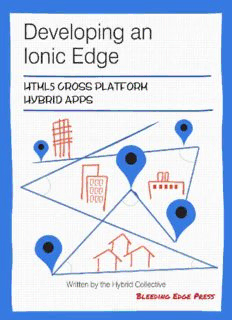
Developing an Ionic Edge: HTML5 Cross Platform Hybrid Apps PDF
Preview Developing an Ionic Edge: HTML5 Cross Platform Hybrid Apps
Developing an Ionic Edge HTML5 Cross Platform Hybrid Apps Here are the true identities of the Hybrid Collective: Robin van Baalen, Alan Levicki, Keith D. Moore, Diego Netto, Anton Shevchenko Developing an Ionic Edge Copyright (c) 2015 Bleeding Edge Press All rights reserved. No part of the contents of this book may be reproduced or transmitted in any form or by any means without the written permission of the publisher. This book expresses the authors views and opinions. The information contained in this book is provided without any express, statutory, or implied warranties. Neither the authors, Bleeding Edge Press, nor its resellers, or distributors will be held liable for any damages caused or alleged to be caused either directly or indirectly by this book. ISBN 9781939902160 Published by: Bleeding Edge Press, Santa Rosa, CA 95404 Title: Developing an Ionic Edge Authors: Robin van Baalen, Alan Levicki, Keith D. Moore, Diego Netto, Anton Shevchenko Editor: Troy Mott Copy Editor: Christina Rudloff Typesetter: Bob Herbstman Cover Designer: Martin Murtonen Website: bleedingedgepress.com Preface With a powerful framework built on AngularJS at its core, Ionic helps developers build rich, robust hybrid mobile applications. With an emphasis on native performance, Ionic plays nice with Apache Cordova to build native-like hybrid mobile applications for both Android and iOS platforms. It even provides its own wrapping command-line interface (CLI) in order to build, test, and deploy Cordova-based mobile applications. With tons of popular mobile components, typography, and a gorgeous and extendable base theme, Ionic has been designed to work and display beautifully and consistently on all current mobile devices. The first alpha release of Ionic was made public in late 2013. While this first release was mainly focused on iOS support, the creators made it very clear from the beginning that they wanted the same performance and behavior on both iOS and Android. After many beta releases and breaking changes, Ionic has released v1.0 RC, which covers both iOS and Android, and we have used it for this book and to create our sample Trendicity application. Why use Ionic? Have you ever found yourself building a mobile application, but essentially duct taping together common components such as a side menu, modals, tabs, and buttons? Or perhaps you have used a mobile-first framework like Twitter Bootstrap that just doesn’t cover enough of what you need? Or perhaps you’ve already built a great mobile application in your desktop browser, only to find yourself stuck with a slow performing application that relies on many DOM manipulations on your devices? If you answered yes to any of the above questions, you know why you should use Ionic. At its core, with the powerful AngularJS framework and a focus on native performance, Ionic is your first go-to library when developing a cross platform mobile application. Many issues like scrolling behavior, long list performance, and tap detection are already taken care of, allowing you to focus on developing your application without the headache of cross platform compatiblity issues. What should readers know prior to reading this book? Before reading this book, you should have at least a basic knowledge of web (application) development in general, including HTML, CSS, and JavaScript. For a better understanding of our example code and Ionic’s features, it is required that the reader has a solid understanding of JavaScript in general and basic knowledge of common AngularJS specific terms. You won’t find a comprehensive reference to AngularJS-specific features or design patterns in this book. Source code/sample app For this book, we, the authors, have developed a demo application for you to play around with and as a reference to the mentioned techniques and features of Ionic. The application is open source and available for free to anyone. Just head over to https://github.com/trendicity/trendicity and get your hands dirty with the source code, or directly clone the repository with git: git clone https://github.com/trendicity/trendicity.git
Description: